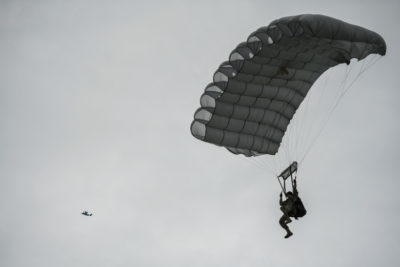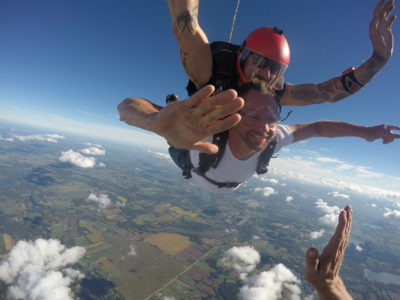- Michigan's Premier Skydiving Center
- Call Now: (517) 423-7720
What is a HALO Jump in Skydiving?
Tuesday, October 22, 2024
- Skydive Tecumseh
- 10/22/24
- 0
- General
Imagine jumping from an airplane at staggering heights, falling through the sky for what feels like an eternity before pulling your parachute. This isn’t your average skydive – it’s an adventure that pushes boundaries and delivers an unparalleled adrenaline rush. Yes, we’re talking about a HALO high-altitude jump. You may have heard of it before but what exactly is a HALO jump skydive and what makes them so special? Well, get ready to explore the extreme side of skydiving, because we’re about to push the bar even higher as we dive into the exciting world of HALO jumps!
What is a HALO Jump?
When most people think of skydiving, they picture jumping from a plane at a standard altitude (around 8,000 to 14,000 feet) and freefalling down to a safe parachute deployment altitude (about 5,500 feet). However, there is a specialized form of skydiving that’s a whole other level of extreme – the HALO jump. HALO is an acronym that stands for High Altitude, Low Opening.
What is Considered a HALO Jump in Skydiving?
So, what is considered a HALO – high altitude jump? Technically any jump performed at altitudes between 15,000 and 35,000 feet is regarded as a HALO jump. According to the United States Parachute Association (USPA), any jump above 15,000 feet must use supplemental oxygen to prevent hypoxia – which is why most dropzones don’t perform civilian jumps above 14,000 feet. However, some dropzones DO offer high-altitude jumps … Keep reading!
Military Origins of the HALO Jump
 The HALO jump was developed in the 1950s as a military technique for covertly deploying troops behind enemy lines. Special forces units, including Navy SEALs, Army Green Berets, and other elite teams, use HALO jumps to infiltrate hostile areas with minimal detection.
The HALO jump was developed in the 1950s as a military technique for covertly deploying troops behind enemy lines. Special forces units, including Navy SEALs, Army Green Berets, and other elite teams, use HALO jumps to infiltrate hostile areas with minimal detection.
Jumpers exit the aircraft at high altitudes – often between 15,000 and 35,000 feet – while wearing oxygen masks to combat the thin air and a military freefall parachute that enables precise control of their descent. They freefall for a significant distance before deploying their parachutes at a low altitude to avoid being spotted.
What is a HAHO Jump?
HAHO jumps are High Altitude High Opening parachute jumps. In a HAHO jump, soldiers also exit the aircraft at high altitudes, but instead of freefalling for long distances, they deploy their parachutes soon after exiting. This allows them to glide long distances – sometimes up to 30 miles – towards their target. HAHO jumps are perfect for when jumpers need to enter a region from far away, avoiding detection by radar or surveillance.
Did Tom Cruise Do a HALO Jump?
Yes, even good ’ol Hollywood has featured HALO jumps. Tom Cruise actually performed his own HALO jumps for his iconic stunt in Mission: Impossible – Fallout. Cruise performed an impressive 106 HALO jumps to capture the scene where he performed a high-altitude jump over Paris. He doesn’t mess around!
HALO vs. Regular Skydiving
While both HALO and regular skydives share the same thrill of freefall, parachute ride, and landing – the differences in altitude, gear, and experience make a … difference! Regular skydives, offered by dropzones around the country and the world, typically occur between 8,000 and 14,000 feet. These jumps allow for a 30 to 60-second freefall at around 120 mph speeds and require basic skydiving equipment and preparation.
HALO jumps occur anywhere from 15,000 to 35,000 feet in altitude and require supplemental oxygen, FAA (Federal Aviation Administration) approval, and additional training. Typically, HALO jumps allow anywhere from 80 to 180 seconds of freefall. How fast do you fall during a HALO jump? The air is much thinner the higher up you go (hence: the required supplemental oxygen) which makes HALO jumpers fall faster at speeds topping around 200 mph!!
Interested in learning more about how altitude impacts your skydive? Check out our blog article on the difference between skydiving from 9,000 and 18,000 feet!
Highest HALO Jump
The highest HALO jump on record was set in 2014 by former Google executive Alan Eustace, who jumped from an incredible altitude of 135,908 feet. While this wasn’t a traditional HALO jump, it still followed the same high-altitude principles. Eustace’s freefall lasted a mind-blowing 4 minutes and 27 seconds and reached a speed of 822 mph, setting another record and achieving a freefall distance of 123,414 feet!!!
Skydive Tecumseh’s HALO Tandem Jump
 Thanks to our powerful Beechcraft King Air at Skydive Tecumseh, we offer an unforgettable HALO jump tandem experience from 18,000 feet – a rare opportunity for tandem students! This means that you can get the thrill of a HALO jump while securely attached to a certified tandem instructor.
Thanks to our powerful Beechcraft King Air at Skydive Tecumseh, we offer an unforgettable HALO jump tandem experience from 18,000 feet – a rare opportunity for tandem students! This means that you can get the thrill of a HALO jump while securely attached to a certified tandem instructor.
What to expect during a HALO tandem jump from this height is approximately 90 seconds of freefall – giving you the most bang for your buck! The preparations and training required for making a HALO tandem jump are the same as those for a normal tandem jump except for the supplemental oxygen you’ll need during the airplane ride to altitude.
Safety & Requirements for Participating in a HALO Jump
For starters, all skydivers – including HALO jumpers – must be at least 18 years old and in good physical health. To execute a HALO jump, the most crucial piece of additional equipment needed is oxygen – not just the ambient air during freefall. Skydivers must start breathing in supplemental oxygen at 8,000 feet for any jump that begins above 15,000 feet.
Each category of HALO jumps for solo skydivers has required specifications that the USPA outlines:
- 15,000 to 20,000 feet requirements:
- Must possess at least a USPA B license
- Must have completed a minimum of 100 jumps
- 20,000 to 40,000 feet requirements:
- Participants are required to hold a USPA C license
- Must have completed at least one jump from 15,000 feet using the same operational bailout oxygen system.
- 40,000+ feet requirements:
- Must hold a USPA D license
- Must have completed at least TWO jumps from below 35,000 feet using the same operational bailout oxygen system.
Of course, your HALO tandem instructor will have met all of these requirements! So, if you’re participating in a HALO tandem jump, are healthy, and meet the normal weight requirement – you’re good to go! If you have any questions or health concerns please consult with a physician before attempting a high altitude skydive.
Ready to embark on the Ultimate Adventure and do a HALO jump? Skydive Tecumseh is one of the very few dropzones that can take you higher than high – so make your first-time skydiving extra special and book a HALO tandem jump with us and show Tom Cruise what’s up! Blue skies.

I drove more than 2 hours to jump with Tecumseh because I wanted a reputable company and I was not disappointed. They were very safety minded and professional. The staff was very friendly and made the whole experience fun! If you're only doing it once, pay the extra and get the video package. Very well done, you won't be disappointed.
Ken Reeves
Copyright © 2025, Skydive Tecumseh, All Rights Reserved.
DropZone Web Design & Marketing by Beyond Marketing, LLC